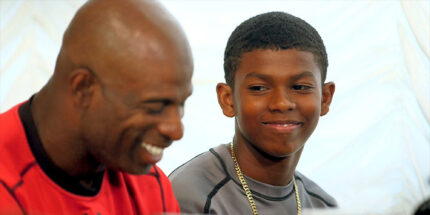Shri Devi Diehl uses her own healing journey and her global awareness to inform how she teaches her “Yoga for Abundant Bodies” workshop in Brooklyn.
There isn’t a single body that isn’t welcomed at Third Root Community Health Center in Brooklyn, NY.
You can see it the moment you walk through the door.
Take a snapshot of one chilly February evening, for example: A group of yoga students — Black, White, Latina, younger, older and queer — unstrap their boots and unravel their scarves to peacefully place them into cubbies. A banner above the receptionist reads, “We all belong. We are all healing”. Another sign in the studio describes the importance of using pronouns according to each person’s chosen gender identity.
While the signs speak for themselves, it was yoga instructor Shri Devi Diehl who set the tone for the night.
She’ll be the first to admit that she doesn’t look like the average American yogi you might see in fitness magazines, or on Instagram, which tend to elevate fair-skin and skinny waists above all other body types.
On the contrary: Diehl is a regal 45-year-old African American woman with natural hair and curves that say, “I am whole.”
On that wintery night, her self-affirming presence felt warm and welcoming. Before class began, Diehl knelt down and spoke to one of her students in Spanish as if they were old friends.
This was Diehl’s “Flow and Restore” class, which is more reflective of her mission to facilitate healing through yoga. But what she’s really known for is creating safe spaces for those who feel marginalized in the yoga world — particularly for people who feel like they have to be a certain size to fit into commercial yoga’s beauty ideals.
Today! Shri Devi teaches Yoga for Abundant Bodies at 4:15. This workshop is a warm and welcoming space for yogis of all shapes and sizes to deepen their practice and build community. Sliding scale $20-45, call us today to preregister. #healthateverysize #fatyoga #brooklynyoga #yogaforeverybody #bodypositivity #curvyyoga #HAES
35 Likes, 2 Comments – Third Root Comm Health Ctr (@thirdrootnyc) on Instagram: “Today! Shri Devi teaches Yoga for Abundant Bodies at 4:15. This workshop is a warm and welcoming…”
In 2012, Diehl started her own workshop called “Yoga for Abundant Bodies” to help others celebrate their bodies, heal their insecurities and foster more self-love.
She sees it as a form of social activism.
“It’s like: How can we tap into all of our abundance and have less narratives around what a pose is supposed to look like and move more into what it feels like?” Diehl told the Shadow League. “The language [I use] is different. The support and the props may be used differently, and I’m hoping that gives folks an opportunity to take what they learn in my class into other spaces.”
Diehl’s passion comes from her own struggle with her body-image as a six-year-old girl.
The Oakland native dreamed of becoming a professional ballerina and dancing for Alvin Ailey one day. But as she attended more dance classes and became increasingly dedicated to her craft, some harmful narratives started to take root in her psyche.
“In ballet [my teachers told me] you cannot have any sort of curve or be of a certain weight,” said Diehl.
It wasn’t long before the young ballerina started picking her body apart in the mirror. Over time, she sustained injuries and continued to train through the pain. Her body stopped feeling. She would be in class and it was as if her spirit did not belong in her own skin. She was dissociating. Her limbs were just going through the motions.
“Dance created this huge sense of angst and trauma, and so I just didn’t want to be in my body,” she said.
When she was 25, Diehl turned to yoga to heal all of the wear and tear from dancing, to quiet the mind and to relieve her chronic insomnia. And it worked for the most part. She learned how to reconnect with her body in a healthy way. She started meditating to quell the anxiety.
“Meditation definitely helped to rewrite the internal narratives and helped quiet the tapes that I found untrue and unhelpful,” she said.
But something still didn’t sit right with her.
In yoga classes, she noticed that most of the students to the left and right of her mat were often Caucasian and skinny. Oftentimes the teacher was no different. Despite leaving the dance world, Diehl’s body was black and curvy in a mainly white industry. Some of her teenaged doubts, judgments and insecurities resurfaced like a sore pimple.
Unfortunately, she found that some yoga instructors weren’t the most comfortable working with people that had her body type. In an American economy where yoga has largely exploded into a fitness trend that’s supposed to give you tight abs, a defined ass and acrobatic flexibility, it’s not hard to imagine why Diehl has felt excluded at times.
“I’ve been practicing for 20 years and I still get looks when I walk into yoga spaces,” she said. “Sometimes I feel completely ignored. Some teachers in a lot of wellness spaces don’t know what to do with our bodies and it’s like: How is my body different from everyone else’s?”
But in 2010, Diehl made a pilgrimage across India that would change her perspective about yoga forever.
“One of the things that I noticed when I started traveling was that there are actually more people that look like us,” she said. “Yoga is used in a lot of indigenous practices, and when I look at it across the world, the majority of people who practice yoga are not white. Many people who practice yoga are not able-bodied, necessarily. The majority of people that I see practice come in all shapes and sizes.”
In some respects, yoga isn’t about the body at all, she added. To her, it is a practice that anyone can use to access their inner temple.
“Yoga helps me to yoke together my mental, my emotional and physical self,” she said. “When I’m really in my practice it’s the closest thing to bliss: It’s this melting together of all of the pieces of you.”
Hello from yoga teacher Shri Devi (she taught Basics and intermediate this morning) and our Friday/Saturday acupuncturist Carmichael! #ThirdRootOpenHouse #mycortelyou #mycortelyouyoga
9 Likes, 2 Comments – Third Root Comm Health Ctr (@thirdrootnyc) on Instagram: “Hello from yoga teacher Shri Devi (she taught Basics and intermediate this morning) and our…”
Today, Diehl uses her own healing journey and her global awareness to inform how she teaches her “Yoga for Abundant Bodies” workshop.
She knows how to make adjustments and find poses that are the most beneficial for each student. Her wife, Kim Diehl, who has practiced yoga for many years, feels like this class is one of the few spaces she doesn’t have anything to prove.
“I feel like I’m practicing the truest form,” said Kim. “I don’t have to do any kind of acrobatics to prove my yoga-ness, you know? I like that [the class] has an affirming vibe.”
Other students appreciate how Diehl opens the floor for discussion and introspection.
“It gave us a chance to talk about the experience of having an abundant body,” said yoga instructor and therapist Magdalene Martinez.
“For me, it was like like coming out in a way,” she added. “Just choosing to go into the class you’re claiming that you have an abundant body. I could talk to people who have the same insecurities. And I remember specifically what [Shri Devi] said when we were doing planks: ‘Take a moment to feel the strength in your body that you have. That’s yours.’ In my head I said: Yes, absolutely. We are all strong.”
For Diehl, this is what the body positivity movement is about: tapping into one’s inner worthiness to shed the harmful fitness narratives of today. Yoga, done in a mindful way, is just one of the paths that can redirect those stories. And Diehl is proving to be an important character in the transformative chapters in many people’s lives.
Just her presence alone encourages others to come as they are to the mat.
“I feel like it’s part of my responsibility to stay engaged because I wish I had seen more people that looked like me when I first started practicing,” she said. “That’s why I practice, and more importantly, that’s why I teach.”



